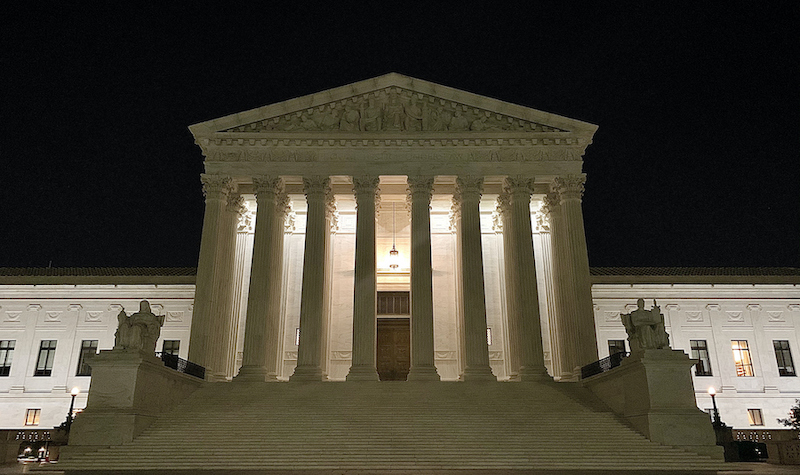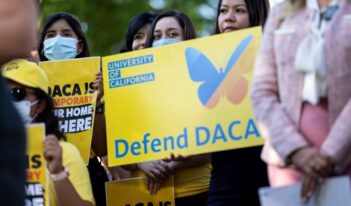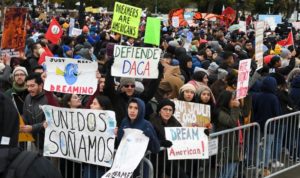
The Supreme Court’s administrative law decisions allow racial animus to motivate policy choices.
Race is in the national spotlight, but it figures less conspicuously in U.S. Supreme Court decisions concerning immigration.
In cases concerning the Deferred Action for Childhood Arrivals (DACA) program, the U.S. Census Bureau, and the Muslim travel ban, the Supreme Court has submerged its analysis of racial animus under an arbitrary and capricious framework. In two of the three opinions, the Court has found government justifications for exclusionary measures to be lacking, but in none of the three decisions has the Court acknowledged race to be the defect.
In the Department of Homeland Security v. Regents of the University of California decision, Chief Justice John Roberts, writing for the majority, specified that the Court’s reasons for striking the DACA rescission turned partly on the reliance interests of a half million DACA recipients—including those who have invested in degree programs, careers, and families, those who are tax paying, and the citizens who depend on their contributions. Yet the Court declined to apply an equal protection analysis and did not include a finding of racial animus or an intent to discriminate.
Justice Sonia Sotomayor was the lone dissenter on the equal protection claim and refused to join that section of the majority opinion. She would have allowed the respondents to develop further the facts underlying their equal protection claim, writing: “I would not so readily dismiss the allegation that an executive decision disproportionately harms the same racial group that the President branded as less desirable mere months earlier.”
Considering the disparate impacts that agency action has on a group could be an alternative way to discern discriminatory intent—but in the DACA case, the Court performed a cursory disparate impacts analysis. In concluding that the respondents had insufficiently pled that racial animus motivated the rescission decision, the Court noted that any immigration policy would adversely affect Latinos more than other groups because Latinos make up such a large proportion of immigrants. The Court also found that the rescission procedure was not irregular because it “was a natural response” to the “newly identified problem” of DACA’s illegality. Finally, the Court determined that the respondents did not identify race-laden statements by relevant agency actors and that President Donald J. Trump’s statements would not “give rise to an inference of discriminatory motive.”
It could instead be argued that all three of these points support the respondents’ position. Over 90 percent of DACA recipients are Hispanic or Latino, the rationales given for the rescission were thin and inconsistent, and President Trump’s numerous anti-immigrant and anti-Mexican statements suggest, as Justice Sotomayor says in her dissent, that “something other than questions about the legality of DACA motivated the rescission decision.” This suggests that the DACA rescission failed the low bar of reasoned decision-making without even reaching the higher bar of strict scrutiny.
Since the Court’s decision in the DACA case, the U.S. Citizenship and Immigration Services has announced it is not accepting new DACA applications and is limiting renewals to one-year periods, in apparent contravention of court orders. The agency’s reasoning resurrects the legal arguments that the Supreme Court rejected as arbitrary and capricious, and it also includes a new reason: Ending DACA promotes child safety by discouraging “a perilous journey to this country.” Given that DACA recipients are not recent arrivals, this seemingly disingenuous justification could give rise to another arbitrary and capricious challenge.
The Court came closer to acknowledging disparate impacts for racial groups in Department of Commerce v. New York, the case about the census’s potential citizenship question. There, the Court established that pretextual justifications for including a citizenship question on the census could not withstand arbitrary and capricious review.
The Court, with Chief Justice Roberts writing for the majority, stated that the decision to reinstate a citizenship question despite the lower response rate that would result could be reasonable under the Administrative Procedure Act’s (APA) arbitrary and capricious standard—but that hiding behind the false pretense of including the citizenship question to protect minority voting rights failed to “ensure that agencies offer genuine justifications for important decisions, reasons that can be scrutinized by the courts and the interested public.” In other words, lying is capricious, but choosing a means of counting that suppresses census participation is not.
Even though contemporaneous statements and a smoking-gun report show that a political strategist recommended adding the citizenship question to advantage non-Hispanic whites in redistricting and acknowledged explicitly that depressing Latinx participation in largely urban districts would favor Republicans, the Supreme Court’s decision carefully avoids discussing racial discrimination per se.
The differentiation of improper motive and suppressed census participation can be also be seen in NAACP v. Bureau of the Census. A coalition of civil rights groups claimed the Bureau’s plan for 2020—involving reduced resources for community outreach and a smaller number of enumerators and field offices—would lead to a differential undercount of racial minorities, in violation of the U.S. Constitution’s Enumeration Clause and the APA.
A federal district court dismissed the civil rights groups’ claim, holding instead that the Census Bureau’s plan would not “unreasonably compromise the distributive accuracy of the census,” even if it was a slimmer operation than in 2010. Affirming the district court decision, the U.S. Court of Appeals for the Fourth Circuit set aside evidence of potentially racially disparate impacts absent direct evidence of animus or deception. Instead, the court recognized the broad discretion of the Census Bureau to conduct a count. The court also found that doing less for racial minorities was not unlawful if the census was doing less for colorblind reasons related to the pandemic or technologies that could compensate for traditional methods of outreach.
The trend continues with still unfolding litigation over President Trump’s executive order seeking to subtract the undocumented population from the overall count reported to Congress. Granted, the 2020 census has been plagued by unique challenges: funding shortfalls, understaffing, delays in printing of the census forms, COVID-19 limitations on the door-to-door outreach of census workers in hard-to-count communities, and litigation over the end date for counting. Yet the court’s problem of overlooking an undercount of communities of color is a persistent one, not merely a product of unfortunate circumstances.
The legal logic of neutral procedures obscuring racial discrimination in government decision-making can also be seen in the Supreme Court’s 2018 decision in Trump v. Hawaii.
The plaintiffs argued that the “President’s stated concerns about vetting protocols and national security were but pretexts for discriminating against Muslims.” The Court upheld President Trump’s travel ban excluding Muslim immigrants for protection of the national interest, notwithstanding clear evidence of racial animus and discriminatory intent. Justice Sotomayor again disagreed with the majority’s unwillingness to broach discriminatory intent, finding evidence of animus and drawing an analogy to Japanese internment.
I have discussed Trump v. Hawaii elsewhere, but it reaches a conclusion similar to those found in the census and DACA cases: Anti-immigrant laws premised on facially neutral purposes are valid under the low bar of rationality.
Similar colorblind reasoning appears in U.S. Immigration and Customs Enforcement efforts to exclude international students—overwhelmingly from China—from college campuses engaged in significant remote education due to the pandemic. Although the rule change was rescinded on the eve of litigation with Harvard College and more than 200 other universities, the universities were prepared to argue that the government’s reasoning was arbitrary and capricious because it ignored the reliance interests of international students and universities who had planned for the 2020 through 2021 academic year in accordance with the emergency guidance issued in March of 2020, which was to remain in “effect for the duration of the emergency.”
Animosity toward immigrants was a driving force in President Trump’s 2016 election, has been a noteworthy element of his Administration’s policies, and has remained a big part of his 2020 re-election campaign. As Justice Sotomayor noted in her dissent in the DACA case, not only were the government’s justifications for the DACA rescission arbitrary and capricious, but the President’s statements helped create “the strong perception” that the decision to end DACA was “contaminated by impermissible discriminatory animus.”
Although the decisions in the DACA and census cases were celebrated, they leave something to be desired. By ignoring racial animus—in the Muslim ban, citizenship question, and DACA rescission—the Court tacitly allows a future administration to make future policies that have racially discriminatory effects, so long as the administration follows the current trajectory of arbitrary and capricious review.
This essay is part of a series entitled Racism, Regulation, and the Administrative State.




